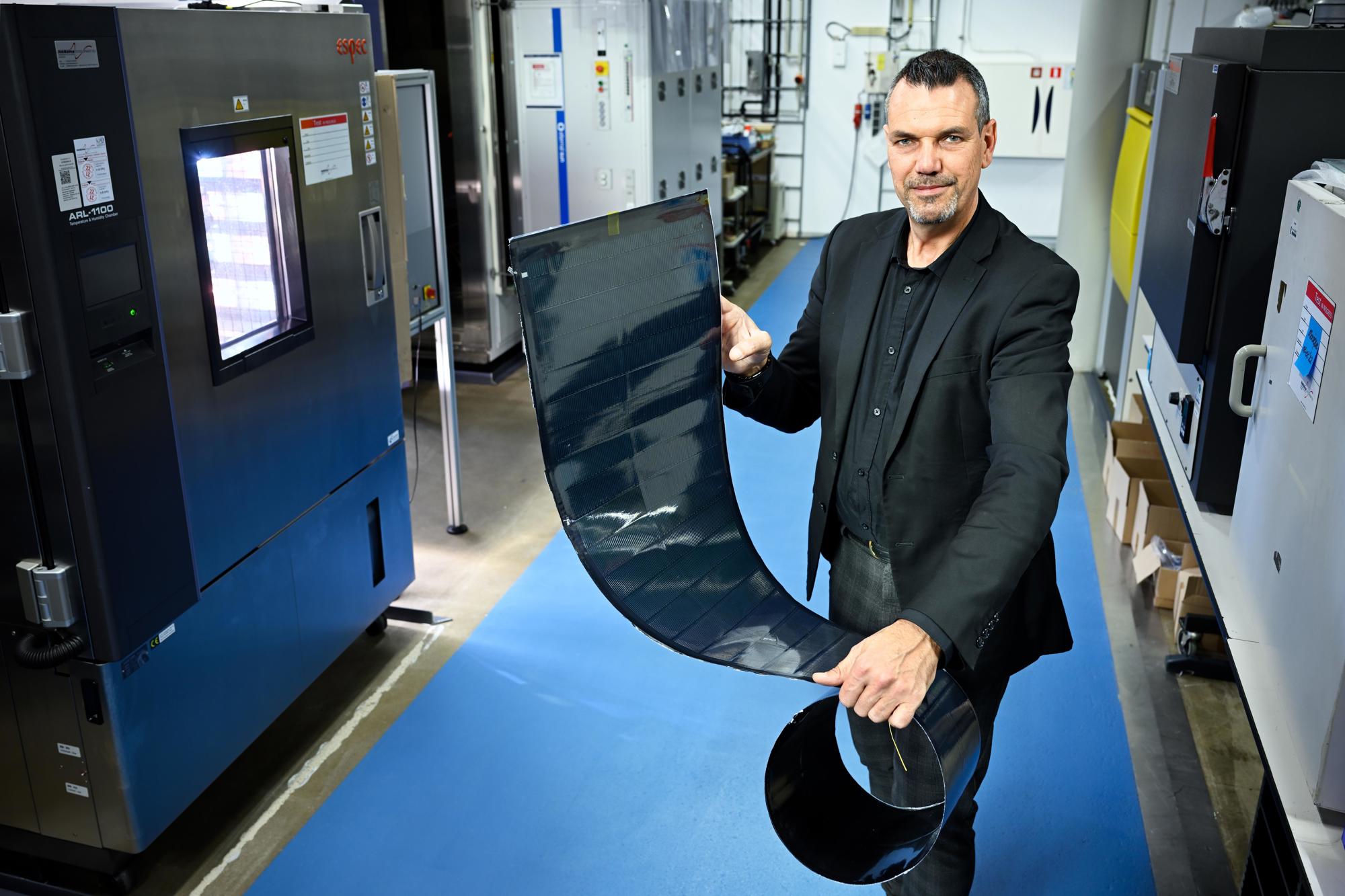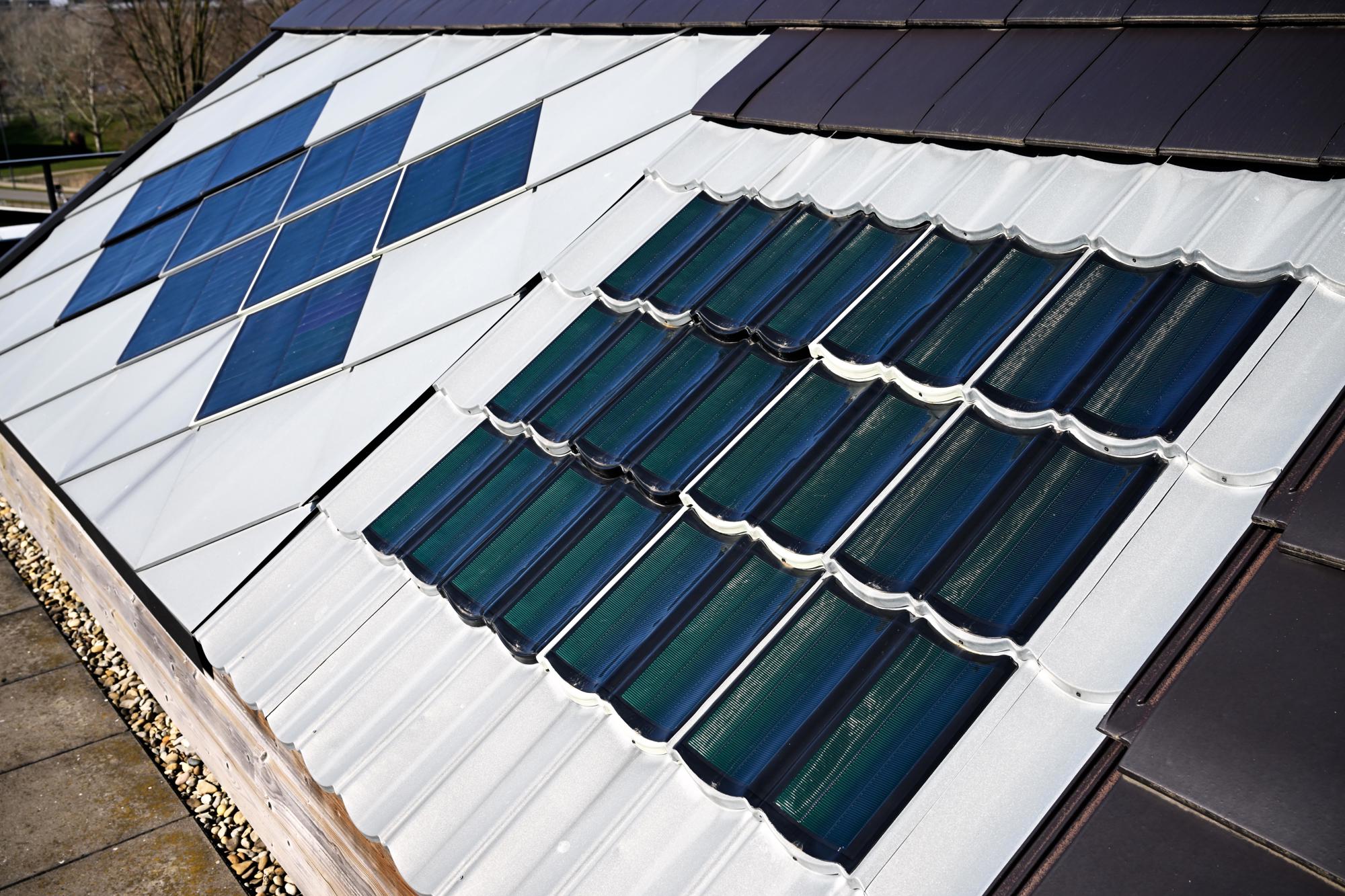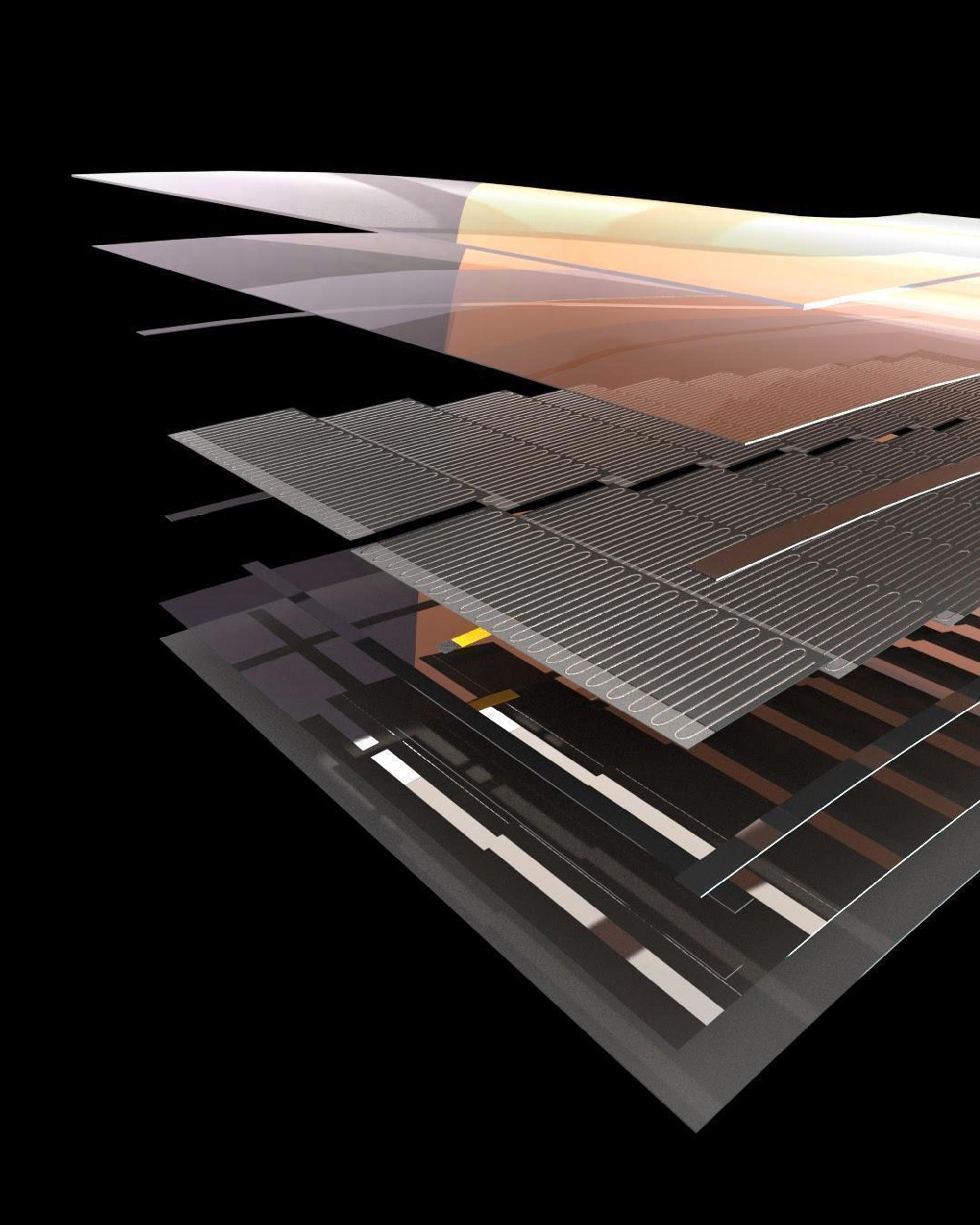As a partner in Solliance, TNO has high expectations for this flexible PV film. The ability to generate solar energy with this thin film may even be the tipping point in the global fight against climate change, in TNO's opinion.
With visible enthusiasm, Peter Toonssen (project developer for TNO at Solliance) outlines the potential offered by incorporating solar cells in various roofing materials and other objects. Not as a retrofit product, like solar panels, but at source during production.
“By offering this widely applicable technology, we can turn the complete shells of the buildings around us into energy-generating power plants”, he says. “Road surfaces, crash barriers, sound walls, cars and lorry trailers; they will all be equipped with this innovation.”

Solar energy is the primary energy source, and also plays a role in all kinds of fuels and even wind energy. More importantly perhaps, it is abundantly available. Consequently, innovations in the field of solar energy are reaching the market in rapid succession.
An obvious next step is to integrate solar power generation into other products at source. Interestingly, this novel idea originates from producers of various roofing materials rather than the solar power industry itself. Manufacturers of innovatively styled roofing panels were keen to make their own product more sustainable and sought contact with TNO to research the idea. Toonssen understands those needs perfectly. “They can present themselves far more powerfully as a green supplier, because their own product will soon go out the door with built-in solar cells.”
Manufacturers were looking for suitable technologies for integrating solar cells in their own products. They soon discovered that most of the potential solutions were limited by fixed dimensions and less than ideal properties. Making a solution themselves was out of the question as the costs would rocket.
So they approached TNO, which engages in research into the solar technology of the future with industrial and academic partners. Since 2010, TNO and the other partners in Solliance have been working at the High Tech Campus in Eindhoven to develop a semi-finished product incorporating solar cells. These other partners are Imec (based in Belgium) and ECN (now part of TNO). Their efforts have been successful, resulting in the development of a thin-film PV technology.
Manufacturers can add this film to their own product. The primary requirement is seamless attachment of the PV film, which is suitable for every possible type of surface, meaning that it can be used universally in building materials, on trains, on building façades and on any other surface that is struck by sunlight.

One in ten Dutch households now has solar panels on the roof. To meet national goals, this number needs to increase by a factor of three in the period up to 2030, and by a factor of ten by 2050. The flexible PV film can greatly increase the output from solar energy systems.
In addition, the use of thin film enormously expands the potential for better utilisation of surfaces for electricity generation. “The majority of buildings and façades are not yet used for PV, so huge gains can be made here”, says Toonssen.
The solar cells can also be incorporated in the environment, infrastructure or means of transport in a visually attractive manner, or even invisibly if required. More and more is possible, even colours and patterns. “That will favour broad acceptance”, he feels. “Many more people will support solar energy if we don't have to fill fields with solar panels.”
The challenges associated with the PV film were mainly technical in nature. Within the partnership, TNO has developed new technology to build a flexible production line capable of meeting the needs of different market segments, and different individual manufacturers. Thanks to robotics, the production line can quickly switch to other products to maintain a high production output.
This is complicated because it involves every stage in the process, from front-end material development to the final product. “There were issues we had to solve in each phase”, Toonssen explains. “Years of preparation were required, but now we can produce significantly large volumes.”
An in-depth knowledge of materials and processes is crucial to the success of this production approach. “We need to have an accurate idea of the reliability of the materials”, Toonssen says. “We don’t want the film to degrade after three years, because the roofing material itself has a life span of at least 20 years. So intensive collaboration with material developers has been a key factor.”
TNO praises the ecosystem of the High Tech Campus in Eindhoven as a highly fertile environment for research and innovation. For example, there is an intensive collaboration with the Holst Centre, one of the few innovation centres to unite expertise in wireless sensor technology and flexible electronics under one roof. Partners can develop demonstration models and prototypes here and then transform them into state-of-the-art products and production processes.

TNO and the other Solliance partners make grateful use of this ecosystem in Eindhoven. “Holst had already solved aspects of all kinds of issues in the field of flexible electronics”, Toonssen points out. “For example, we benefited greatly from their knowledge of barrier technology, which protects the electronics from gases from the atmosphere.”
Short distances also help generate ideas. “On campus, you can meet up for coffee and have a quick chat about progress. Doing the rounds like this gives you spontaneous access to ideas. Stretchable films are a case in point. Holst has already explored concepts for this. At the coffee machine, we discussed whether we could also apply those ideas to the solar cells.”
The push for solar panels is intertwined in many ways with strengthening the regional economy of Brabant and beyond. A significant percentage of solar panel production is located in Asia.
The Netherlands and Europe are very much in favour of bringing the entire supply chain back to continental Europe. “Not just to assemble parts here; we also want local production”, Toonssen clarifies. “A company in Asia has trouble offering producers in Brabant the service they need. If we produce the PV film here, we can respond instantly.”
This approach will result in a regional solar industry that meets specific local needs. “Manufacturing activity has been increasingly relocated abroad in recent years. It’s important now that we keep manufacturers here, particularly in technologies where we lead the world.”
When developing the film, TNO and the other Solliance partners also looked explicitly at recyclability and the availability of the required components. “Customers demand that we work with materials that are readily available. They don't want products that might lead to a sustainability problem.”
There are still several metals and other materials that TNO prefers not to use, such as lead and indium. “We are looking for sustainable alternatives to these metals. In any case, our product is wafer-thin, so we need far fewer raw materials than traditional solar energy products.”
Within the Solliance partnership, there is intensive collaboration with education and knowledge institutions, including all the technical universities and Avans University of Applied Sciences. Avans students handle many of the assignments involved in developing the technology.
“Students have high creativity”, Toonssen comments. “And they are also potential employees for any future business we set up. In some fields, attracting talented people is almost impossible. This is especially true of electrical engineering. Finding a good employee is often a matter of luck.”

This year, TNO hopes to develop the flexible PV film further to the point where commercial partners can actually start integrating it into their products. TNO expects to realise game changers with two or three producers. The first application of PV film is obvious: in roofing materials. After that, other surfaces will follow. “In about five years, you will be seeing this film on quite a few buildings and other surfaces,” Toonssen predicts.
The Netherlands can generate its own energy with these high-quality integrated solar cell applications, eliminating the need to import energy from other countries. “Every building has to become climate neutral, so the majority of companies will choose this route.”
“Actually, we should have done this much earlier”, he comments. “The high gas prices are a powerful wake-up call. This development illustrates the importance of controlling your own energy supply.”
There is also an important pay-off. A rapid transition to solar energy is no longer an expensive must, but rather an economically interesting development. For Brabant as well. “When people talk about the energy transition, cost is always the main obstacle”, says Toonssen. “We see something else: huge opportunities, because it will create a completely new market. It marks the start of a new economy.”
Brabant is in a position to fully exploit these opportunities. “By working even more explicitly on research and innovation, we in the Netherlands can lead the way, with a vibrant hotspot in the Eindhoven region. When you think about it, the whole world is one big solar cell.”
You can copy the full text of this story for free at the touch of a button